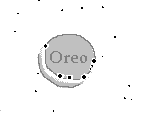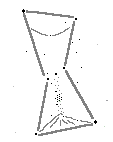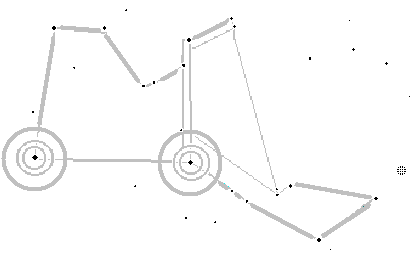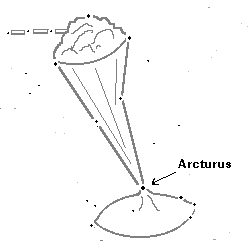The New LCAS Sky Map
Jack Kramer
Who hasn't looked up at a constellation and wondered, "How did they ever see the figure of a _____ in that group of stars?" While some star patterns look a bit like what they're supposed to portray, most of them simply don't. From ancient times through the Renaissance, astronomers were grouping stars into constellations and "connecting the dots" to form images that gave names to the groupings. But images thus created were usually meaningful only in that other place and time. Ursa Major is the classic case; it's much better known as the "Big Dipper" than as a bear. To help newcomers to the hobby remember the constellations, LCAS has compiled its own "Uranometria" by associating more believable images with some familiar star patterns.
Obviously, there's Sagittarius -- a star pattern that certainly doesn't look like a half-man and half-horse. To most observers, it looks like a teapot, as shown below, so let's call it a Teapot! A further measure of realism is afforded by the Lagoon and Trifid nebulae that serve nicely as two puffs of steam coming from the spout.
The Teapot
Cassiopeia surely doesn't look like a fair maiden sprawled across the sky. Although some refer to this grouping as the "W", a mere letter is rather pedestrian for a constellation. Therefore, the LCAS Committee on Nomenclature and Standards re-identified Cassiopeia as a recliner-type lounge chair -- a "Stratolounger", to be specific.
The Stratolounger
Next up is Bootes. It takes a lot of imagination to see a herdsman in that group of stars. It might look to some like a long, thin kite, but that's still a stretch even if you allow the bright star Arcturus to be the tip of your kite's tail. So we have re-cast it in a more believable form. Behold the Ice Cream Soda constellation!
The Ice Cream Soda
Adjacent to the Ice Cream Soda is the former Corona Borealis (the "Northern Crown"), which really never looked like a crown. In Richard Preston's book First Light, we read that the famed Oreo cookie is the snack of choice for astronomers at Mount Palomar. According to Preston, "I had decided that the first maxim of survival on Palomar Mountain is that those who eat Oreos live to see the dawn." What better way to honor this icon of astronomical snackdom than with its own place in the cosmos. So now we have the new constellation... Oreo Cookie

Then there's the bright winter constellation Orion. Doesn't it look more like an hourglass than a hunter? This has now been rectified in our sky map. Of course there's the southern hemisphere constellation Horologium, but that's a clock. Now we have an older timekeeper -- the Hourglass with the nebula M42 serving as a big blob of sand falling down.
The Hourglass
Another constellation we addressed was Pegasus. Now we all know that winged horses don't really exist, and to make matters worse, the poor horse is pictured upside-down in our sky. Therefore, we decided instead to honor those mainstays of the highway department and creators of traffic tie-ups, the dreaded construction equipment. All the ancient road builders had were baskets and strong backs! So now we have the Front-End Loader scooping up the globular cluster M15.
The Front-End Loader
There is much work still to be done in updating the constellations. In the meantime, use your own perception. For example, if Draco doesn't look like a dragon, call it the way you see it. How about the "Wet Spaghetti Noodle" constellation?
You'll probably never again look at constellations in quite the same way.






